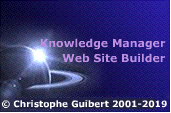|
Tree :
Faceted index, by topics :
Menu
"Main" tree view (1) "Normal" view (15) Display (4) Edit (9) File (52) Help (7) Ideas (57) Import/Export (16) Keywords (6) Publications (19) Tasks (1) Templates (72) Windows (1)
Feature
Category
How to insert these widgets? |
More precisely, WIT is based on an internal representation template of electronic document, made up of structured elements allowing a total control of final rendering. This rendering deals with structure and style of elements making up the Web site. A Web site is generally made up of a home page, using or not some frames, and, in this case, one of these frames can be used as a quick access way to site content (site map, table of contents, ...). Beyond the home page, the site is made up of the useful pages. Each page complies to a common structure (HTML header (meta tags), background, page header (general title...), page footer, navigation bar ...). Each page hosts one, several or all current document ideas. Each idea is made up of elements which display, order and individual structure can be modified (title, idea text, keywords, image lists, like to other ideas, bibliographic references, etc...). Last but not least, the Web site includes WIT automatically calculated elements : table of contents, title numbering, keyword indexes, glossaries, list of bibliographic references. In addition, to each element of structure is associated a style of presentation (color, font, size, margins, etc...) defined according cascading style sheets syntax (CSS), such as the W3C recommends. |

